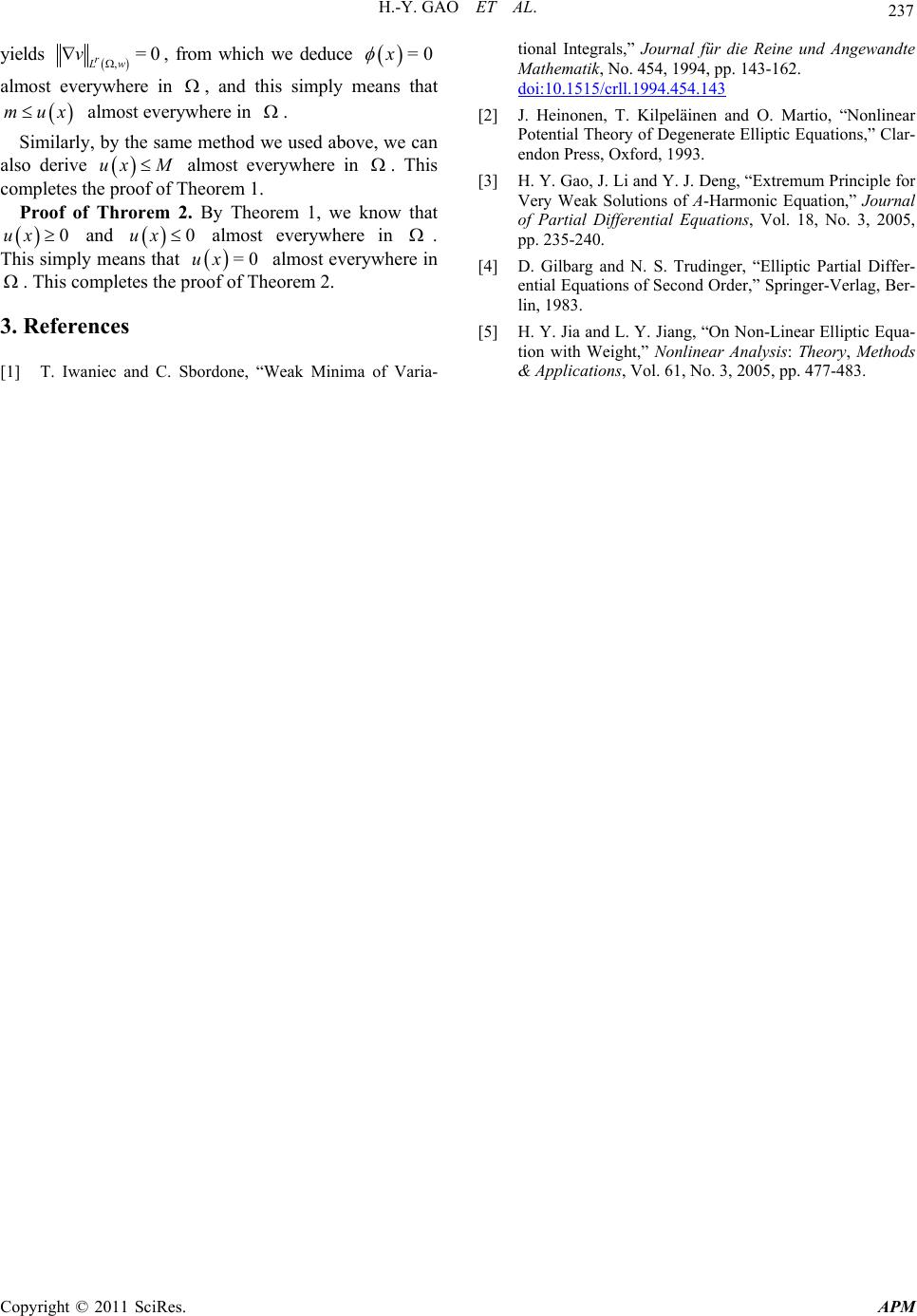Paper Menu >>
Journal Menu >>
 Advances in Pure Mathematics, 2011, 1, 235-237 doi:10.4236/apm.2011.14041 Published Online July 2011 (http://www.SciRP.org/journal/apm) Copyright © 2011 SciRes. APM Extremum Principle for Very Weak Solutions of A-Harmonic Equation with Weight* Hong-Ya Gao, Chao Liu, Yu Zhang College of Mathematics and Computer Science, Hebei University, Baoding, China E-mail: 578232915@qq.com Received March 2, 2011; revised April 11, 2011; accepted April 20, 2011 Abstract Extremum principle for very weak solutions of A-harmonic equation ,div Axu0 is obtained, where the operator :nn A RR satisfies some coercivity and controllable growth conditions with Muckenhoupt weight. Keywords: A-Harmonic Equation, Muckenhoupt Weight, Extremum Principle, Hodge Decomposition 1. Introduction Throughout this paper will stands for a bounded regular domain in , . By a regular domain we understand any domain of finite measure for which the estimates (1.6) and (1.7) for the Hodge decomposition are justified, see [1]. A Lipschitz domain, for example, is regular. n n R2 Given a nonnegative locally integrable function , we say that belongs to the w w p A class of Mucken- houpt, , if 1< p< 1 11 11 dd= sup p p p QQ Q wxwxA w QQ < (1) where the supremum is taken over all cubes of . When , replace the inequality (1.1) with Qn R =1p M wx cwx for some fixed constant and a.e. cn x R, where M is the Hardy-Littlewood maximal operator. It is well-known that 1 p A A whenever , see [2]. We will denote by >1p Lw, p, 1<<p , the Banach space of all measurable functions f defined on for which 1 ,d< P p p Lw ffxwxx The weighted Sobolev class consists of all functions 1, , p W w f for which f and its first generalized derivatives belong to ,Lw p. We will need the following definition. Given ,uv 1,r W , 1r< , the function 1 ==min 2uv uvuv 0, also belong to 1,r W . The chain rule gives =uv if <ux vx and =0 if >ux vx. We say xux v on in sobolev sense, or symbolically, uv if the function defined above lies in 1, 0 r W . Consider the following second order divergence type elliptic equation (also called A-harmonic equation or Leray-Lions equation) div,=0Ax u (2) where :nn A RR is a Carathéodory function and satisfies 1) ,, p Ax wx , 2) 1 , p Ax wx , where 1< <p , 0< < are fixed constants, and 1 wx A be a Muckenhoupt weight. The proto- type of Equation (2) is the -harmonic equation with weight p 2 div= 0 p wx uu *Research supported by NSFC (10971224) and NSF of Hebei Province (A2011201011).  236 H.-Y. GAO ET AL. Definition: A function with is called a very weak solution of (2) if 1, , r uW w max 1,1p<rp ,,d=Ax ux 0 (3) for all 1,1 , rrp W w w = w with compact support. Recall that is a weak solution of (2) if (3) holds for all with compact support. The word very weak in the above definition means that the Sobolev integrable exponent of u is smaller than the natural exponent . 1, , p uW w 1, (,) p W p r Extremum principle for weak and very weak solutions of elliptic equations is an important and basic property. It is closely related to the uniqueness results for some boundary value problems of elliptic PDEs, see [4]. Motivated by this property, Gao, Li and Deng showed in [3] the extremum principle for very weak solutions of (2) with the weight . In the present paper, we generalize the result obtained in [3] to weighted case, and prove the extremum principle for very weak solutions of (2). The main result of this paper is the following theorem. 1wx Theorem 1: Suppose that be a Muckenhoupt weight. There exists 2 , such that if is a very weak solution of the 1 wA 11 =,rr uW ,,,<<npw pr 1, , rw 2,,,,rnp A -harmonic Equation (1), and on in the sobolev sense, then mux M m almost everywhere in , provided that . ux M 12 <<rrr With the extremum principle at hand, we can consider the 0-Dirichlet problem 1, 0 ,= r div Axu uW 0 (4) Theorem 2: Let and 2 be the exponents in Theorem 1 and 12 . Then the 0-Dirichlet bound- ary value problem (4) has only zero solution. 1 r <<rr r r We will need the following lemma in the proof of the main theorem, which is a Hodge decomposition in weighted spaces. Lemma: [5] Let be a regular domain and wx be an 1 A weight. If , 1, 0, p uW w 1< <p , 1<1< p , then there exist ,Ww 1, ( 0 p )/(1 ) and a divergence-free vector field , 1p H Lw such that uu h (5) and 1 1 , pp p 1 1 ,, pp p L wLw hCAwu (7) where =p and =,,CCnpw depending only on and , respectively. p,,npw 2. Proof of Theorem 1 and Theorem 2 Proof of Throrem 1. If ux is a very weak solution of the Equation (2), then also is 1, = r vxuxm Ww ,. For every test function 1 1, 0, p rL Ww , we have ,, d=Ax ux 0 (8) Now let =min0,v . It is easy to see that w 1, 0, r W . Consider the Hodge decomposition of rp , = rph , L w CA wu Lw (6) By Lemma, we have the following estimate 1 1,, rp rrp r p L wLw hCAwrp (9) The integral identity (8) with as a test function of class 1, 1 0, rrp W w takes the form ,,d= ,,d rp A xux Axuhx (10) Let us put =:<Xx vx 0 Since the gradient of is equal to on X, while it vanishes on v X , then for this choice of the integral in (10) reduces to ,,d= ,,d rp XX A xv vvxAxvhx By the conditions 1) and 2), the above equality yields dd rrp XX vwxv hwx Using Hölder’s inequality and (9) we obtain 1 1 ,, d d rp rrp r Lw Lw X r pX vwxh CA wprvwx 2 (11) Taking sufficiently close to to satisfy 1 <<rprp 1 =p CA wpr and 2 =p CA wrp . Thus, if , then 1 <<rrr 2 =< p CA wpr 1 (11) Copyright © 2011 SciRes. APM  H.-Y. GAO ET AL. Copyright © 2011 SciRes. APM 237 yields ,=0 r Lw v , from which we deduce =0x almost everywhere in , and this simply means that almost everywhere in . mux Similarly, by the same method we used above, we can also derive almost everywhere in ux M . This completes the proof of Theorem 1. Proof of Throrem 2. By Theorem 1, we know that and almost everywhere in 0ux ux0 . This simply means that almost everywhere in . This completes the proof of Theorem 2. =0ux 3. References [1] T. Iwaniec and C. Sbordone, “Weak Minima of Varia- tional Integrals,” Journal für die Reine und Angewandte Mathematik, No. 454, 1994, pp. 143-162. doi:10.1515/crll.1994.454.143 [2] J. Heinonen, T. Kilpeläinen and O. Martio, “Nonlinear Potential Theory of Degenerate Elliptic Equations,” Clar- endon Press, Oxford, 1993. [3] H. Y. Gao, J. Li and Y. J. Deng, “Extremum Principle for Very Weak Solutions of A-Harmonic Equation,” Journal of Partial Differential Equations, Vol. 18, No. 3, 2005, pp. 235-240. [4] D. Gilbarg and N. S. Trudinger, “Elliptic Partial Differ- ential Equations of Second Order,” Springer-Verlag, Ber- lin, 1983. [5] H. Y. Jia and L. Y. Jiang, “On Non-Linear Elliptic Equa- tion with Weight,” Nonlinear Analysis: Theory , Methods & Applications, Vol. 61, No. 3, 2005, pp. 477-483. |

